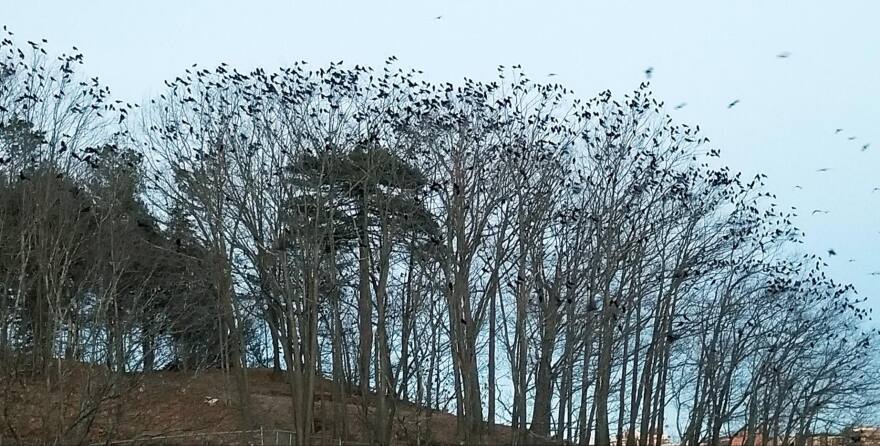This time of year, there's an evening spectacle taking place in treetops in cities, towns and around the countryside. Hundreds, and in some cases thousands, of crows are congregating in winter roosts.
https://www.youtube.com/watch?v=EmJRhZdc7Pk
Many of them are local birds that will go on to raise extended families in suburban backyards and nearby woodlots. Others are migrants from as far away as Canada who will return home once spring arrives to stay. Either way, the crows create an impressive sight and sound around Lewiston and Auburn.

You begin to notice them about an hour before dusk. While pausing at a traffic light, you might spot a few dozen crows flying high overhead. Or if you're on foot, like Carey Davis, you might look up and see the sky swirl and darken as their numbers grow.
“I just kept looking as I was walking across the bridge, up the hill to here and they just kept coming,” Davis says.
Mike Boone and his son were on their way home from soccer practice and stopped to watch the gathering. Boone says he's noticed that the crows have several different roosts in Lewiston and Auburn not far from one another.

"It's just amazing,” he says. “There's so many of 'em every night around this time and, ah, you just drive through town and you can see them for miles."
Follow them for a few minutes and their winged procession will lead you straight to the corvid motherlode: an enormous roost of active, noisy crows.
"It's hard to keep my thoughts straight, just watching birds like this," says Doug Hitchcox, a staff naturalist with Maine Audubon.
Hitchcox has come to check out this large congregation of American crows in the twin cities of Lewiston and Auburn.
Close your eyes and you could mistakenly believe that you're in the African Serengeti, but these crows are communal, urban dwellers. On this night they've settled in some tall trees on the edge of a parking lot behind the Lewiston Department of Public Works. Peering through his binoculars, Hitchcox estimates this particular flock contains at least 10,000 birds. It sounds like an unusually large number, but Hitchcox says flocks of birds like this used to be a common sight.
"We've lost so many birds to a number of things, but when you hear about accounts of flocks of passenger pigeons by the millions, now they're completely extinct,” he says. “It makes you wonder to see how amazed we are by a few thousand birds, and to think that there were things like passenger pigeons going overhead by the millions a hundred years ago."

Even today, much larger roosts of crows have been documented, including one in Auburn, New York that dates back to 1913, with one hundred thousand crows and another in Oklahoma with two million.
In literature, not science, large flocks like these are often referred to as a murder. And while crows, which are considered to be the most intelligent and social of all birds and tend to mate for life, they're often maligned as harbingers of evil or as a sign of death.
Who can forget the famous scene of school children being attacked by an angry mob of crows - in Alfred Hitchcock's 1963 horror film - "The Birds?"

But Doug Hitchcox says the crows aren't gathering for any nefarious reason. They do it, scientists believe, to stave off predators like the Great Horned Owl, stay warm, look for mates and possibly share some news.
"You've got all these birds probably coming in from probably various places that they've been feeding throughout the day,” he says. “There are some people that think there's an exchange of information going on so maybe crows are coming together - not that we could ever tell what they're actually saying - but maybe they're saying they found a big field full of grain."
"You know, there is no Captain Crow who tells everybody, 'OK guys, tonight we're going this place. It's all a group decision that gets made," says Dr. Kevin McGowan of the Cornell Lab of Ornithology.

McGowan has been banding and studying crows in his adopted hometown of Ithaca, New York for more than 30 years. He says crows are so smart they can remember a person's face and learn to associate certain behaviors and sounds.
"I've got a number of families that know me pretty well because I toss 'em peanuts just as a snack type thing,” he says. “And they know when my garage door opens up. They know the sound of that and they'll come over and they'll chase my car down the street. And they come zipping across the street. It's like wait, wait, wait, trying to catch up to the car."

McGowan says crows roosting in urban areas is a trend that began, not so coincidentally, in the late 1970s, once it became illegal to shoot them. But in recent decades West Nile Virus has taken a heavy toll on crows in New York State and other places, causing concern for both scientists and bird enthusiasts who reject the notion that a huge gathering of crows is anything other than a natural marvel.
Large roosts like the one in Lewiston will begin breaking up during mating season in the next few weeks and then reappear with the setting sun by winter.
Updated 4:55 p.m. March 6, 2019







